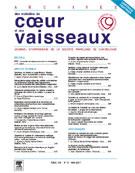Efficacité d’un réseau pour la prévention secondaire chez les patients coronariens - 26/03/08
T. Denolle,
A. Sharareh,
M. Dib,
M.-F. Agaesse,
V. Auguste,
H. Boutier,
C. Bouvet,
J. Maillard,
A. Richard,
F. Revault d’Allonnes
Voir les affiliationsObjectif : Améliorer la prévention secondaire chez les patients coronariens.
Methodes : Cent-trente-et-un patients coronariens (56 % au décours d’une angioplastie, 24 % en post-pontage et 20 % sous traitement médical) âgés de 61 ans (32-79 ans) avec 11 % de femmes, 48 % d’hypertendus, 24 % de fumeurs, 10 % de diabétiques et 72 % de dyslipidémiques non équilibrés (LDL > 1 g/l) ont été comparés à un an avec la cohorte française de l’étude EuroAspire II (365 patients – Lancet 2001). Ils ont adhéré à un réseau de soins qui leur proposait un programme d’éducation de quatre semaines en ambulatoire constitué d’une éducation physique avec 22 séances de réadaptation cardiaque, d’une éducation thérapeutique et diététique (18 cours et ateliers) avec un suivi à trois, six et douze mois par l’équipe paramédicale. Une formation pour les professionnels de santé (médecins et infirmières) a été réalisée avec rappel des recommandations et ateliers sur les facteurs de risque. Les patients étaient suivis par un dossier médical partagé informatisé. La PA (moyenne de trois mesures par OMRON M4 : % ≪ 140/90mmHg), le cholestérol total (CT : ≪ 5 mmol/l), l’obésité (IMC > 30), l’activité physique (insuffisante si inférieure à trois fois 30 min par semaine), le tabagisme ont été analysés à J0, en fin de stage puis à un an et comparés aux résultats français d’EuroAspire II.
Résultats : (*p ≪ 0.05)

Conclusion : L’adhésion des patients coronariens dans un réseau de soins permet d’améliorer très significativement la prise en charge de leurs facteurs de risque. Néanmoins, le bénéfice du stage s’estompe avec le temps.
Effectiveness of a health network in secondary prevention among coronary patients |
Objective: To improve the secondary prevention, particularly hypertension management among coronary patients.
Methods: In 2004-2005, out of 175 coronary patients having taken part in a cycle of the Educoeur center of the health network Rivarance, 131 (75%) aged between 32-79 years of age (an average of 61 years with 11% women, 52% hypertensive, 24% smokers, 10% diabetics and 72% with unbalanced dyslipidemia (LDL > 1g/l)) were re-examined within 12 months and were compared with a French cohort of the EuroAspire II study (365 patients - Lancet 2001). 56% were treated by angioplasty, 24% by coronary bypass and 20% by medical treatment. The 4-week ambulatory educational program consisted of a physical education with 22 meetings of cardiac rehabilitation (ergo cycle, carpet, segmentary muscular work, steps and balneotherapy) and a therapeutic and dietetic education (18 courses and cooking workshops, supermarket visits and self BP measurement). These 131 patients were re-examined 3, 6 and 12 months after by the paramedical team. The GP and nurses were taught recommendations on CV risk factors management. The patients were followed by a computerized medical file. BP (average of 3 measurements by OMRON M4), total cholesterol (CT), weight, physical activity (insufficient if less than 3 walks of 30 min per week), smoking and drugs intake were analyzed on J0 then at one year and were compared with the French results of EuroAspire II.

Conclusion: The education and the follow-up of the patient in a network of health improve CV risk factors and particularly hypertension management of these coronary patients but this decreases with time.
Mots clés :
Prévention secondaire
,
réadaptation cardiaque
,
éducation thérapeutique
Plan
© 2007 Elsevier Masson SAS. Tous droits réservés.
Vol 100 - N° 8
P. 625-629 - août 2007 Retour au numéroBienvenue sur EM-consulte, la référence des professionnels de santé.

